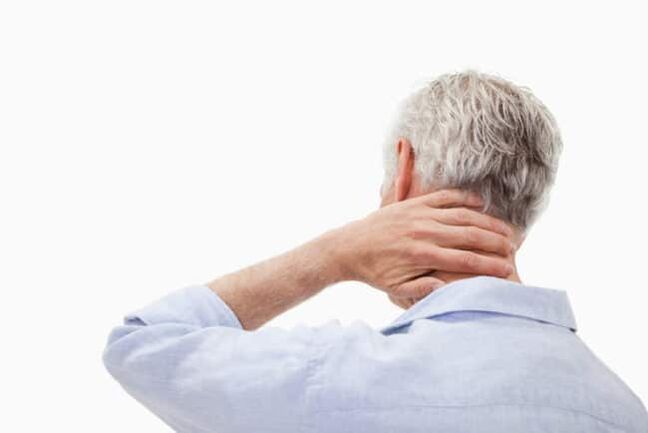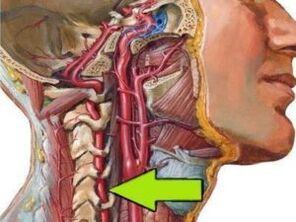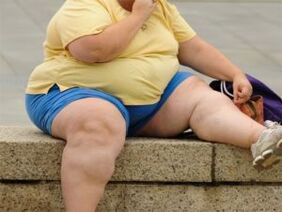Among all pathological processes affecting the spine in different parts, cervical osteochondrosis is considered to be one of the most common and painful.This disease causes many complications, mainly because it affects the spinal cord and adversely affects the functioning of the brain.

What is cervical osteochondrosis?
The words of cervical osteochondrosis in medical practice means a progressive disease that affects the specific spine.This pathological process is characterized by degenerative dystrophic processes in intervertebral disc tissues, which are cervical vertebral shock absorbs.Degenerative dystrophic changes in the intervertebral discs are due to the fact that they are deleted and deformed.As a result, the distance between the vertebrae is reduced, resulting in the following effects:
- Narrowing of the spinal canal in certain areas of the spine.
- Switching to spinal arteries - large blood vessels that provide blood supply to the brain.Which causes the brain to supply the brain and blood circulation in the cervix is impaired.
- Intervertebral discs can be deformed and flattened.This leads to the extortion of individual spinal cord and nerve sections, and more often the nerve roots are compressed.
All these problems are not only threatened by the cerebral blood flow, a painful sensation in the neck, headaches, etc.The development of osteochondrosis of the cervical region is dangerous with neurological problems, with the deterioration of the central nervous system, damage to the brain tissue.According to the classification of international diseases, several separate codes were given osteochondrosis of the cervical region.ICB 10 Disease Code depends on the age of the disease: the disease was diagnosed:

- M02 - intervertebral disc dystrophy in adolescence.
- M42.12 is a dystrophic process in the neck for adults.
Many factors depend on the age of the patient and the stage of development of the pathological process, such as consequences, complications, symptoms and, of course, treatment principles.
Cause
Knowing the causes of the development of osteochondrosis of the cervical region, the diagnosis can play a crucial role in the diagnosis, as well as determine the principles of combating the disease.However, before listing the reasons, it is worth saying that doctors distinguish between two factors leading to the development of this pathological process:
- Pathologically, the destruction of intervertebral discs and other vertebrates with the involvement of nearby tissues, blood vessels and nerve rays in the pathological process due to adverse external factors.The more difficult these factors and other pathologies, the sooner the disease develops.
- Physiologically based on the development of pathology, mainly age -related changes.We are talking about the natural aging of cartilage tissue in the spine, salts, etc.
If we list more specific causes of cervical osteochondrosis, they are as follows:
- Violation of metabolic processes in the body as well as at certain stages of obesity.
- Hypodynamia is a phenomenon characterized by a mobility limit.This applies not only to injuries or illnesses, but also a sedentary lifestyle and sitting.
- Cardiovascular abnormalities, promoting impaired blood circulation in the brain, pressure changes and other things.
- Incorrect posture, they have various scoliosis, rheumatism and even flat foot shapes.
- Cervical injection of the spine.In this case, we are talking about sprains, strikes, bruises.Other spinal studies in the development of cervical osteochondrosis may affect the development of cervical osteochondrosis.
- Excessive physical activity in the cervical region caused by intense sports or severely physically difficult, depending on the activity of the person.
- A sedentary lifestyle is also dangerous with permanent cervical spine and all spinal tension if you sit wrong or on uncomfortable furniture.
- Cervical spine hernia as well as various related diseases.
- Forced long -lasting head holding in an awkward or unnatural condition.In this case, not only the muscles are excessive, but the spine is convex in the cervical region.
- Doctors consider constant stress and nervous overvoltage as very common.
- One of the reasons is also considered to be congenital abnormalities in the spinal structure.

What are the danger to health?
As mentioned above, the cervical spine contains not only the spinal cord and various nerve branches, but also the arteries of the spine, which supply the brain, the brain and the medullavic of the brain.In the development of cervical osteochondrosis, nearby tissues are inflamed.In addition, the development of pathology threatens to squeeze nerve roots and transfer blood vessels, the consequences are:
- Osteochondrosis is accompanied by deformities of the spine, the effects of which are narrowed in the cerebrospinal channel in some places.This can lead to extortion of the spinal cord and nerve branches, which promises severe neurological problems.In severe cases, people experience pain, even have the ability to lose control of individual parts of the body (mainly in the hand or face).
- Squeezing the neck vessel, as already mentioned, is accompanied by a circulatory damage in the cerebral occipital region.At the same time, the brain no longer receives oxygen and nutrients in the required quantities, and oxygen starvation begins.With circulatory disorders, there is a real risk of ischemic stroke and various neurological pathologies.
Syndromes
The main syndromes are:
- Spine.
- Spinal artery.
- Koreshka.
- The heart.
It is important to know that each of these symptoms is accompanied by different natural painful feelings as well as many adverse clinical signs.A person may feel dizzy, noise in the ears and much more.

Vertebra syndrome
It talks about the direct link between osteochondrosis of the cervical region with bones and cartilage tissues.Symptoms of this type of pathology are also associated with these tissue damage:
- Neck movements are partially or fully restricted.
- Head movements are accompanied by neck pain.
- X -RAY shows morphological changes in tissues (in the intervertebral and vertebra body).
It is worth noting that vertebral syndrome is always accompanied by these three clinical signs.If at least 1 of them, the diagnosis will be completely different.
Rook syndrome
This happens when the roots of the spinal cord are damaged.At the same time, nerve conductivity is impaired, a person may feel pain or lose the sensitivity of individual parts of the body or even suffer from paralysis.Depending on which of the 8 radicular couples there is conductive disorder, the following symptoms are distinguished:
- 1 couple - numbness or pain in the back of the head;
- 3 pair - chewing reflex violation, tongue numbness and discomfort behind the ears;
- 4 pair - pain clavicle, swallowing reflex violation;
- 5 pair - shoulder lumbar lesion, accompanied by hand movement problem;
- 6 pair - the patient begins to feel pain and numbness in the forearm and shoulder blades;
- 7 pairs - hands and fingers are numb (often index and middle);
- 8 pair - problems similar to the previous object, but numbness is felt in the ring and a small finger.
Cardiac syndrome
Despite the fact that the pathological process is still localized to the cervical spine, the syndrome has all signs of cardiac abnormalities.The clinical picture is as follows:
- Fast pulse.
- Pain in the sternum.
- Shortness of breath, weakness, lethargy, reduction in performance.
Signs and symptoms of cervical osteochondrosis
In order to seek a doctor in a timely manner, it is necessary to clearly understand the signs of cervical osteochondrosis.In some cases, such knowledge allows you to seek help in the early stages of the disease when it is easier to treat.Usually the symptoms of osteochondrosis of the cervical spine are as follows:

- Pain in osteochondrosis is always only intensity and frequency.The first clinical sign is pain.Their intensity depends on the stage of disease progression, in nature they are stupid or squeezed.Painful feelings mainly occur in the neck of the occipital region, but they can also radiate to the time region, shoulder belt and hands.
- In most cases, there are manifestations of the vestibular apparatus.We are talking about frequent dizziness without causes, nausea, impaired movement coordination, uneven course, loss of space.
- One of the most common clinical signs is the firmness of the neck muscles and the rigidity of movement.It is difficult for a person to rotate, lower and throw his head, the movements reacts with pain struggles.
- Many patients note the feeling that goose balls are "running through the scalp" or characterized by tingling.
- There is muscle weakness and numbness in the arm area.
- There are often psychological manifestations expressed in depression, drowsiness, sharp changes in mood, temperament or irritability.
- Due to impaired blood circulation and damage to the brain tissue, dizziness increases and noise appears in the ears, similar to snake, pulsation, ringing.
- Most patients note visual impairment as well as eyeball pain, especially when trying to significantly mow the eyes left, right, up or down.
Sometimes it is possible to determine the degree of development of the pathological process with symptoms.However, it is still not enough to diagnose it and requires several diagnostic measures.
Diagnostic methods
The diagnosis of osteochondrosis of the cervical spine is necessary to determine the localization and stage of the disease.The following diagnostic methods are needed for full diagnosis:
- X -RAY - The main method to determine the degree and localization of the spinal deformity.
- You can use computed tomography to more accurately diagnose pathological changes in the vertebrae and intervertebral discs.
- MRI (magnetic design imaging) - allows you to study the wheels and vertebrae in detail, detect hernia, the presence of protrusions and the scale of other lesions.
- Dopplerography - At the same time, the test becomes an opportunity to find a place for extortion of the artery, to evaluate the degree of circulatory disorders.
Treatment methods
Treatment of osteochondrosis of the neck always means an integrated approach.The principles of treatment depend on the mass of factors such as the age of the patient, the stage of development of the disease, the brightness of the clinical picture, etc.However, in this situation, you cannot do without a doctor and you can first consult a therapist who will then move you to a vertebrologist.Speaking of an integrated approach: osteochondrosis of cervical osteochondrosis is treated using drug therapy, physiotherapy, massage, exercise therapy and other methods that should be discussed in more detail.
Drug treatment
The basis for cervical osteochondrosis is drug therapy, which includes the use of such a group of tablets, drugs and drugs:
- Anesthetics - analgesics and antismodics.Former dull nervous centers, thus stopping painful feelings.The latter allows you to reduce the spasm of the neck muscles by creating blood flow and suppressing pain.
- NSAIDs -Non -steroidal anti -inflammatory drugs are needed to reduce the inflammatory process, most of them also prevent pain.Often this medicine is used in the form of gels, ointments that are thrown into the affected area.
- Musorelaxants are another way to remove muscle spasm in the cervical region.
- Chondroprotectors are mandatory in the osteochondrosis stages of osteochondrosis as they promote bone tissue regeneration.
- B vitamins - Normalize nerve tissue metabolic processes, improving nerve impulse conductivity and promoting the work of the central nervous system.
Remember that treatment should only be done under the supervision of a physician, who is responsible for the appointment of each medicine, as well as for its intake and dose.
Physiotherapy
Treatment of osteochondrosis of the neck will be much more effective with some physiotherapy methods:

- Electrophoresis.
- Laser therapy.
- Ultrasound.
- Massage.
Massage therapy is required by an experienced health worker, and treatment is performed at least 10 sessions.Cervical massages help to normalize blood circulation, restore elasticity, muscle tone, relieve pain, etc.
Manual therapy
Manual therapy is based on the principle of engine function and the restoration of mobility between the vertebrae.Initially, manipulations are easy to relax in massage, then the doctor attaches more and more strength, acts on pressure vertebrae and neck turns.
The use of Kuznetsov applicators is one of the methods of spinal disease, including osteochondrosis.The effect of adaptation on the cervical region normalizes metabolic processes, relieves pain, increases muscle tone, improves blood circulation, increases nerve tissue conductivity, etc., to prevent osteochondrosis, it is useful to swim every day and hang on the horizontal band for 2-3 minutes.


























































































